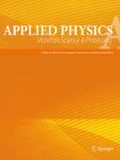Abstract
Iron-boride layers on low-carbon steel were produced by thermochemical diffusion process. The surface interaction products: Fe2B, FeB, FeBx (x>1) and a solid solution of iron in boron were identified by surface Mössbauer spectroscopy (CEMS and XMS). Samples of original and boronized steel were subjected to corrosion process by immersion in HCl (0.1 N) solution for 150 h. While the steel sample was strongly corroded, none corrosion product was found on the boronized sample surface. However, significant changes in relative percentages of the various iron boride phases were detected. Also, samples of original and boronized steel were subjected to oxidation process by heat-treatment in air at 300°C for 8 h and 500°C for 4 h. At 300°C, while bulk Fe3O4 and α-Fe2O3 were formed on the steel surface, none iron oxide was detected on the boronized surface. At 500° C, while only pure bulk α-Fe2O3 was detected on the steel surface, a particle size distribution ofγ-Fe2O3, with particle size of about 100 Å, was probably formed on the boronized surface, as evidenced by CEMS.
Similar content being viewed by others
References
Bundesministerium für Forschung und Technologie, Deutschland (BMFT), Forschungsbericht T 76-38. „Tribologie (Reibung-Verschleiß-Schmierung)“ (Juli 1976)
M. Carbucicchio, L. Bardani, G. Palombarini: J. Mat. Sci.15, 711 (1980)
J.G. Stevens, G.K. Shenoy (eds.):Mössbauer Spectroscopy and its Chemical Applications (American Chemical Society, Washington DC 1981)
M. Carbucicchio, G. Meazza, G. Palombarini: J. Mat. Sci.17, 3123 (1982)
A. Handa, Y. Ujihira: J. Mat. Sci.18, 1887 (1983)
Agostinho A.G. Campos, MSc. Thesis, Departamento de Fisica, UFMG (1981) (unpublished)
H.K. Chow, R.F. Weise, P. Flinn: Mössbauer Effect Spectrometry for Analysis of Iron Compounds, USAC report NSEC 4023-1 (October 1969)
I.D. Weisman, L.J. Swartzendruber, L.H. Bennett: Phys. Rev.177, 465 (1969)
T. Shinjo et al: J. Phys. Soc. Jp.19, 1252 (1964)
H. Bunzel, E. Kreber, U. Gonser: J. Physique12, C6–35,609 (1974)
F. Stanke, F. Parak: Phys. Stat. Solidi (B)52, 69 (1972)
W. Kündig, R.S. Hargrove: Solid State Commun7, 223 (1969)
Y.F. Krupyanskii, I.P. Suzdalev: Sov. Phys. JETP38, 859 (1974)
T. Tsuji, K. Naito, K. Ishigure: Phys. Stat. Solidi (a)82, K57 (1984)
Y.S. Dorik et al: J. Appl. Phys.56, 2566 (1984)
Y. Fujio: Jpn. J. Appl. Phys.12, 1850 (1973)
M.J. Tricker, J.M. Thomas, A.P. Winterbottom: Surf. Sci.45, 601 (1974)
W. Keune, U. Gonser: Thin Solid Film7, R7 (1971)
F.J. Berry: J. Chem. Soc. Dalton Trans. 1736 (1979)
T. Shinjo, T. Iwasaki, T. Shigematsu, T. Takada: Jpn. J. Appl. Phys.23, 283 (1984)
Author information
Authors and Affiliations
Rights and permissions
About this article
Cite this article
Abras, A., Campos, A.A.G., de Carvalho, A.V. et al. Conversion electron and X-ray Mössbauer studies of boronized low-carbon steel under corrosion and oxidation conditions. Appl. Phys. A 41, 185–189 (1986). https://doi.org/10.1007/BF00616838
Received:
Accepted:
Issue Date:
DOI: https://doi.org/10.1007/BF00616838




